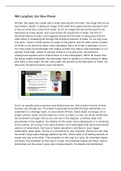Class notes
Class notes SUST1000 (SUST1400) - week 11 (Element cluster - water)
- Course
- SUST1000 (SUST1400)
- Institution
- Dalhousie University (Dal )
Will Langford, Our Blue Planet Steve Mannell, The Quest for Pure Water Steve Mannell, Water, Disease, and Public Health Will Langford, Chlorine, Chemistry, and the Ambivalence of Scientific Improvement Steve Mannell, The Sanitary City: Toronto,
[Show more]



